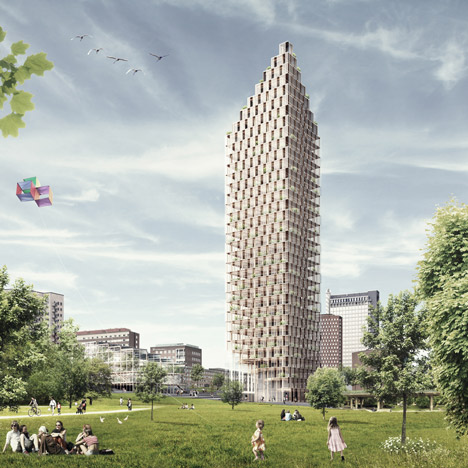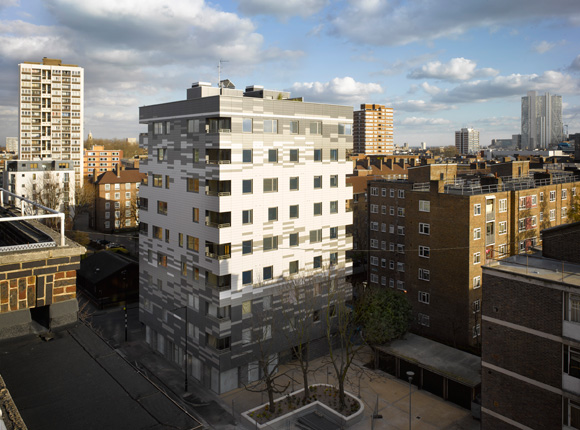
Courtesy of Michael Green Architecture
Sure, you can build a multi-story timber building if you want to. That’s two concepts above. And here’s a design for one in Stockholm:

Here’s another concept, for somewhere in the US, by architect Michael Charters:

You can even head here to watch time-lapse videos of the construction of this one, in Prince George, Canada.

In 2011, this was the world’s largest timber apartment block, Bridport House in
And “the video on this page shows a prime example of the use of timber in a multi story buildings. Murray Grove Apartments (Stadhaus in Hackney was at the time was the world’s tallest modern-timber residential building. [Hat tip NZ Wood, who have here a “study undertaken by Canterbury University researchers and others, funded by the Ministry of Agriculture and Forestry, looked at the environmental benefits of maximising wood use in multi-storey buildings.”]

And here’s a 10-storey .
So it’s not only possible, to many people it’s desirable. Easy to build. Using plantation timber. Ductile in earthquakes. Fine even in fire1.
But timber isn’t the only structural material to use in tall or multi-storey buildings.
You can use timber. But you can also use concrete, or steel, or stone, or mud. You can use ferrocement, glass, even baked clay.
But do you want to?
And whose choice should it be?
And how would government subsidising one particular material or system unfairly impinge on producers of other materials or systems? (Come on, you know this one.)
Not every material suits every context, is the most desirable to new owners, or is most economic in every context to build and maintain. The reason materials are selected are many, but subsidising one in favour of another suggests government knows better than builders what they should be selecting.
Steel frame buildings are light and quick to erect, but need extra work protecting frames from fire and lots of detailing for movement. Concrete frames offer structure and fire protection in one go, and can easily be designed for seismic loadings – although while they should protect during a quake, they may not be serviceable afterwards. Timber frames are good, light and ductile, but the joints between posts and beams are difficult to make fully moment resistant.
You choose your material to suit your context.
Everyone – every building owner and buyer – is entitled to choose their own way of building, or should be2. It’s their business, not the the business of government to tell them what materials they should use, nor to pick favourite material suppliers to support and subsidise.
A subsidy that encourages producers to spend less time innovating and more time sucking up to government to get their own subsidy,
So to all those National Party supporters opposing David Cunliffe’s moronic Muldoonist manifesto to subsidise forestry owners, which opposition is sensible, don’t get me wrong, I ask you why you’re not also opposed to government regulation of building, which unjustly favours some construction systems over others.
Let’s be consistent, shall we.

2. As long as they take their own risk.


1 comment:
Nice post. Glad someone has also blogged about Cunliffe's latest edict.
Post a Comment